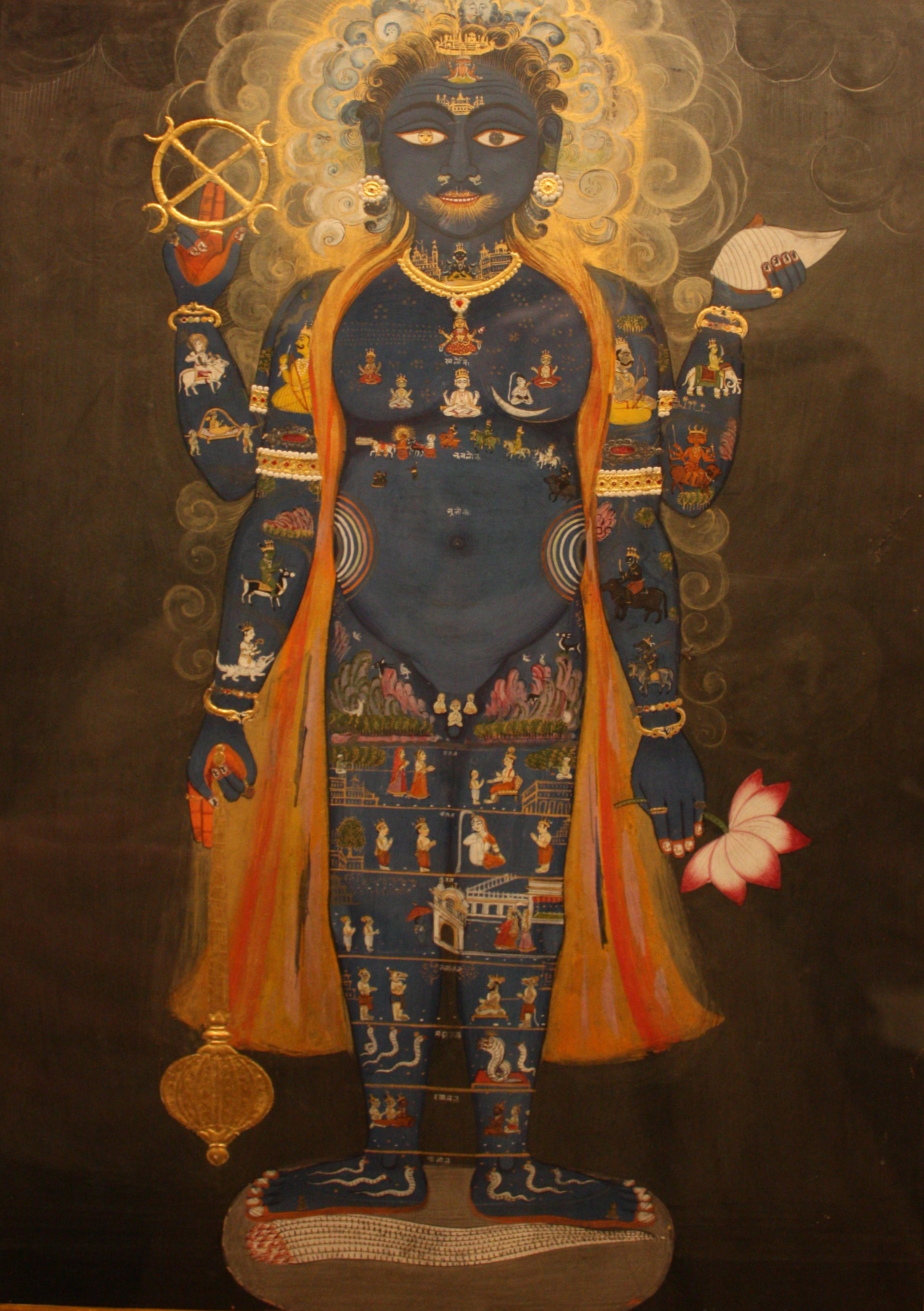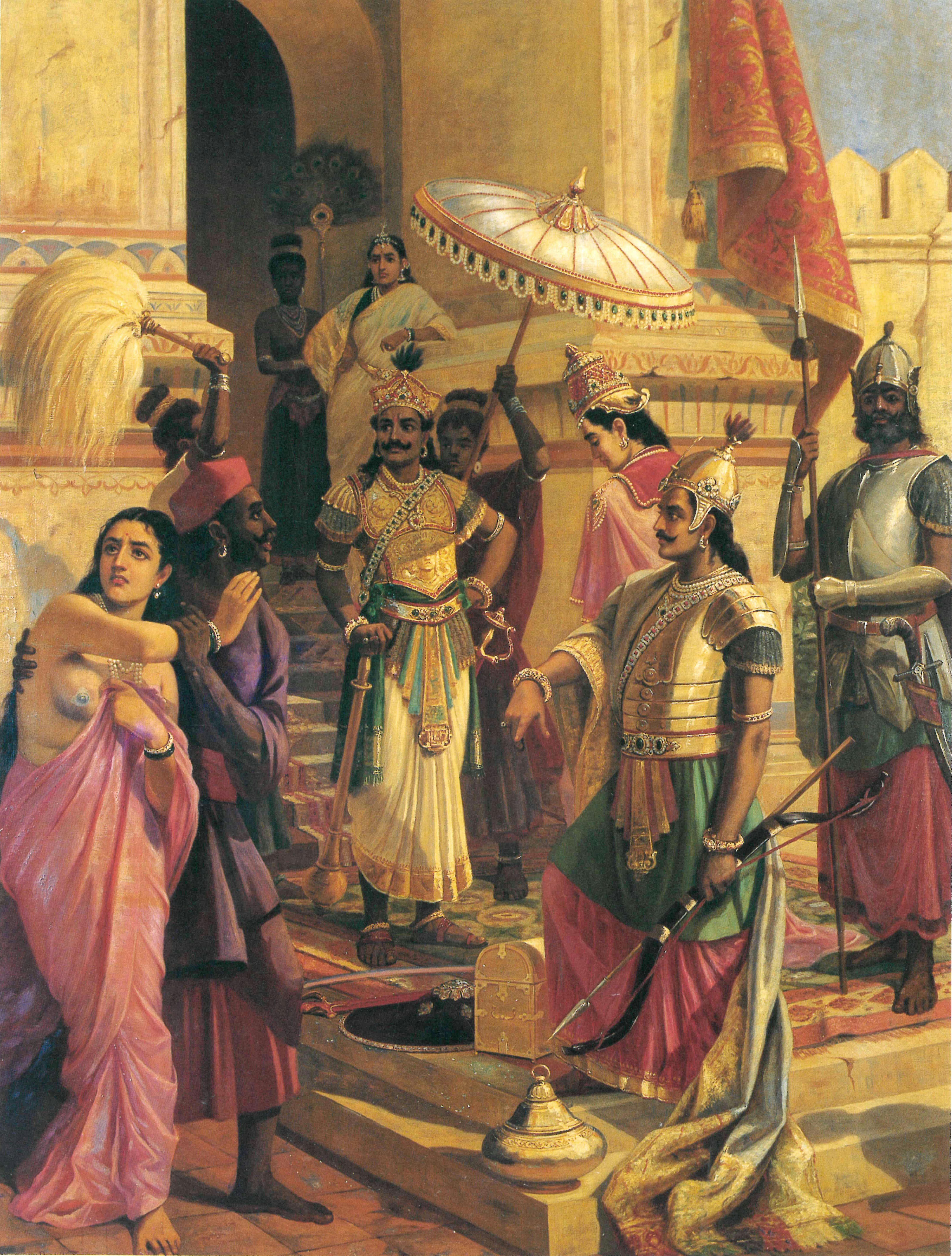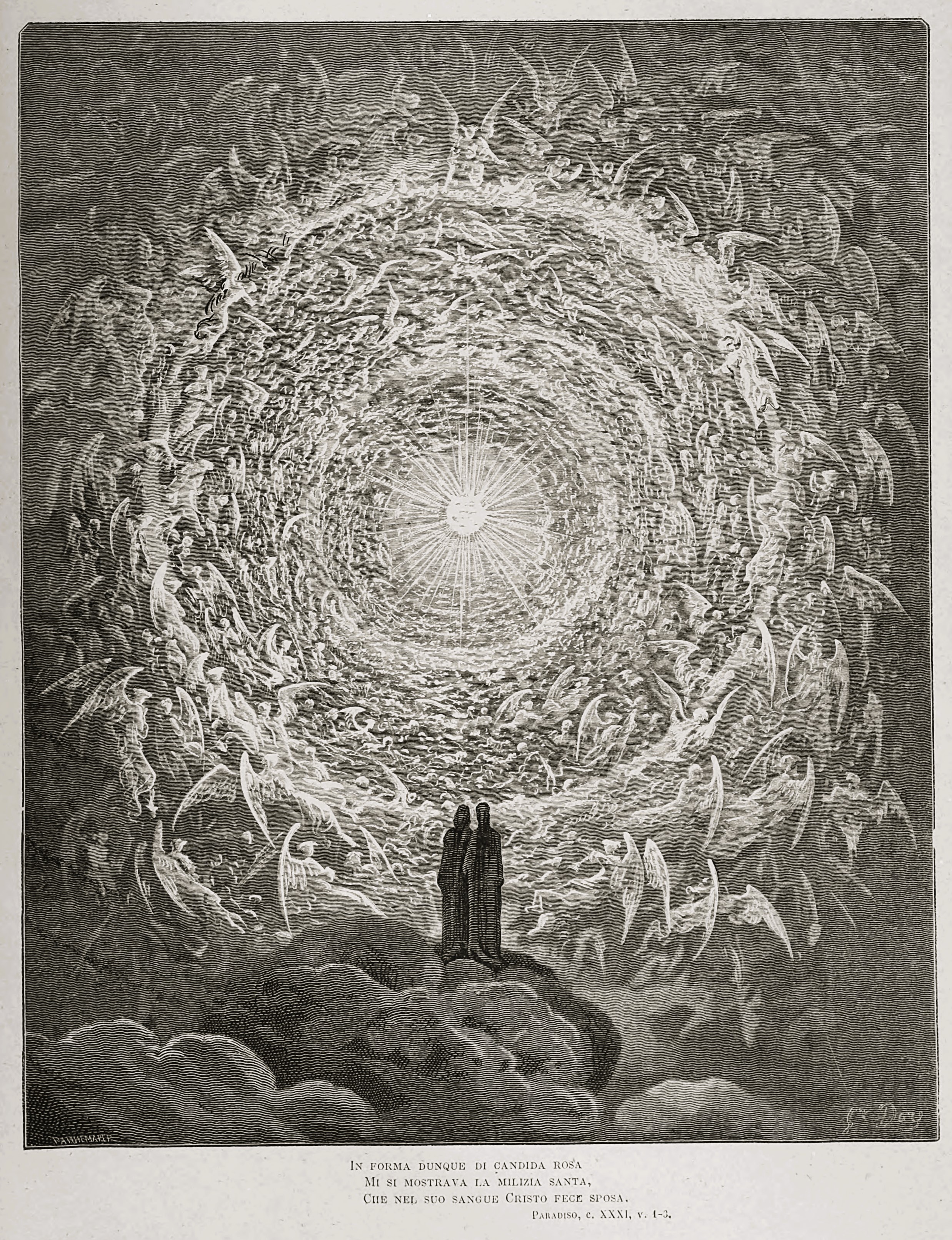|
Svarga
Svarga (, ), also known as Swarga, Indraloka and Svargaloka, is the celestial abode of the devas in Hinduism. Svarga is one of the seven higher lokas ( esoteric planes) in Hindu cosmology. Svarga is often translated as heaven, though it is regarded to be dissimilar to the concept of the Abrahamic Heaven. Description Svarga is a set of celestial worlds located on and above Mount Meru, where those who had led righteous lives by adhering to the scriptures delight in pleasures, before their next birth on earth. It is described to have been built by the deity Tvashtar, the Vedic architect of the devas. The king of the devas, Indra, is the ruler of Svarga, ruling it with his consort, Indrani. His palace in the abode is called Vaijayanta. This palace holds the famous hall, Sudharma, unrivalled among all the princely courts. The capital of Svarga is Amaravati, and its entrance is guarded by the legendary elephant, Airavata. Svarga is described to be the home of Kamadhenu, the c ... [...More Info...] [...Related Items...] OR: [Wikipedia] [Google] [Baidu] |
Loka
Loka () is a concept in Hinduism and other Indian religions, that may be translated as a planet, the universe, a plane, or a realm of existence. In some philosophies, it may also be interpreted as a mental state that one can experience. A primary concept in several Indian religions is the idea that different lokas are home to various divine beings, and one takes birth in such realms based on their karma. Hinduism Three lokas The most common classification of lokas in Hinduism is the Trailokya, or the three worlds. The concept of the three worlds has a number of different interpretations in Hindu cosmology. In Hindu literature, the three worlds refer to either the earth (Bhuloka), heaven ( Svarga), and hell (Naraka), or the earth (Bhuloka), heaven (Svarga), and the netherworld ( Patala) Bhuloka In the Narada Purana, Bhuloka is identified with the planet Earth, the world of human beings. It is described to be split up into seven regions, referred to as dvipas (islands). T ... [...More Info...] [...Related Items...] OR: [Wikipedia] [Google] [Baidu] |
Indra
Indra (; ) is the Hindu god of weather, considered the king of the Deva (Hinduism), Devas and Svarga in Hinduism. He is associated with the sky, lightning, weather, thunder, storms, rains, river flows, and war. [3 volumes] Indra is the most frequently mentioned deity in the ''Rigveda''. He is celebrated for his powers based on his status as a god of order, and as the one who killed the great evil, an Asura (Hinduism), asura named Vritra, who obstructed human prosperity and happiness. Indra destroys Vritra and his "deceiving forces", and thereby brings rain and sunshine as the saviour of mankind. Indra's significance diminishes in the post-Vedic Indian literature, but he still plays an important role in various mythological events. He is depicted as a powerful hero. According to the ''Vishnu Purana'', Indra is the title borne by the king of the gods, which changes every Manvantara – a cyclic period of time in Hindu cosmology. Each Manvantara has its own Indra and the In ... [...More Info...] [...Related Items...] OR: [Wikipedia] [Google] [Baidu] |
Samudra Manthana
The Samudra Manthana () is a major episode in Hinduism that is elaborated in the Vishnu Purana, a major text of Hinduism. The Samudra Manthana explains the origin of the elixir of eternal life, amrita. Nomenclature *Sāgara manthana (सागरमन्थन) – ''Sāgara'' is another word for '' Samudra'', both meaning a sea or large water body. *Kshirasāgara manthana (क्षीरसागरमन्थन) – ''Kshirasāgara'' means the ocean of milk or milky ocean. ''Kshirasāgara'' = ''Kshira'' (milk) + ''Sāgara'' (ocean or sea). *Amrita Manthana (अमृतमन्थन) – ''Amrita'' means the elixir. “''Churning for the Elixir”'' Legend Indra, the King of Svarga, was riding on his divine elephant when he came across the sage Durvasa, who offered him a special garland given to him by an apsara. The deity accepted the garland and placed it on the trunk (sometime the tusks or the head of the elephant in some scriptures) of Airavata (his mount) as a tes ... [...More Info...] [...Related Items...] OR: [Wikipedia] [Google] [Baidu] |
Amaravati (mythology)
Amaravati ( ) is the capital city of Svarga, the realm of Indra, the king of the Deva (Hinduism), devas, in Hinduism, Buddhism, and Jainism. It is also called Devapura, ‘city of the devas’ and Pūṣābhāsā, ‘sun-splendour’ in the Puranas. Description In Hindu tradition, Amaravati was built by Vishwakarma, Vishvakarma, the architect of the devas, a son of Brahma, but sometimes also depicted as a son of Kashyapa. At the centre of Amaravati is Vaijayanta, the palace of Indra, or Śakra (Buddhism) in Buddhism. The heaven of Indra is a region for the virtuous alone, with celestial gardens called ''Nandana Vana'', that houses sacred trees, like the wish-fulfilling Kalpavriksha, as well as sweet-scented flowers such as hibiscuses, roses, hyacinths, freesias, magnolias, gardenias, jasmines, and honeysuckles. Fragrant almond extract is sprinkled on the sides of palaces. The fragrant groves are occupied by apsaras. Low sweet music is stated to play in this land. Indra's abode ... [...More Info...] [...Related Items...] OR: [Wikipedia] [Google] [Baidu] |
Hindu Cosmology
Hindu cosmology is the description of the universe and its states of matter, cycles within time, physical structure, and effects on living entities according to Hindu texts. Hindu cosmology is also intertwined with the idea of a creator who allows the world to exist and take shape. Substance All matter is based on three inert ''Guṇa, gunas'' (qualities or tendencies):James G. Lochtefeld, Guna, in The Illustrated Encyclopedia of Hinduism: A-M, Vol. 1, Rosen Publishing, , pages 224, 265, 520Theos Bernard (1999), ''Hindu Philosophy'', Motilal Banarsidass, , pages 74–76 * ''sattva'' (goodness) * ''rajas'' (passion) * ''Tamas (philosophy), tamas'' (darkness) There are three states of the ''gunas'' that make up all matter in the universe: * ''pradhana'' (root matter): ''gunas'' in an unmixed and unmanifested state (equilibrium). * ''Prakṛti, prakriti'' (primal matter): ''gunas'' in a mixed and unmanifested state (agitated). * ''mahat-tattva'' (matter or Hiranyagarbha, univers ... [...More Info...] [...Related Items...] OR: [Wikipedia] [Google] [Baidu] |
Pralaya
Pralaya () is a concept in Hindu eschatology. Generally referring to four different phenomena, it is most commonly used to indicate the event of the dissolution of the entire universe that follows a '' kalpa'' (a period of 4.32 billion years) called the ''Brahmapralaya''. Pralaya also refers to ''Nityapralaya'', the continuous destruction of all animate and inanimate beings that occurs on a daily basis, ''Prakritapralaya'', the great flood produced by Prakriti (Nature) that ends all of creation after the completion of 1,000 Chaturyuga (four-age) cycles, and ''Atyantikapralaya'', the dissolution of one's Atman (Self) due to its union with Brahman (Ultimate Reality). A concept that has been referenced in literature since the Upanishads, the concept of pralaya has been widely discussed in Hindu cosmology as well as philosophy. Description Hindu cosmology posits an endless cycle of the periodic creation and destruction of the universe. Nityapralaya Nityapralaya refers to ... [...More Info...] [...Related Items...] OR: [Wikipedia] [Google] [Baidu] |
Hindu Mythology
Hindu mythology refers to the collection of myths associated with Hinduism, derived from various Hindu texts and traditions. These myths are found in sacred texts such as the Vedas, the Itihasas (the ''Mahabharata'' and the ''Ramayana''), and the Puranas. They also appear in regional and ethnolinguistic texts, including the Bengali ''Mangal Kavya'' and the Tamil '' Periya Puranam'' and ''Divya Prabandham''. Additionally, Hindu myths are also found in widely translated fables like the ''Panchatantra'' and the '' Hitopadesha'', as well as in Southeast Asian texts influenced by Hindu traditions. Meaning of "myth" Myth is a genre of folklore or theology consisting primarily of narratives that play a fundamental role in a society, such as foundational tales or origin myths. For folklorists, historians, philosophers or theologians this is very different from the use of "myth" simply indicating that something is not true. Instead, the truth value of a myth is not a def ... [...More Info...] [...Related Items...] OR: [Wikipedia] [Google] [Baidu] |
Narasimha
Narasimha (, , or , ), is the fourth avatara of the Hindu god Vishnu in the Satya Yuga. He incarnated as a part-lion, part-man and killed Hiranyakashipu, ended religious persecution and calamity on earth, and restored dharma. Narasimha has three eyes, and is the God of Destruction in Vaishnavism; He who destroys the entire universe through (Pralaya). Hence, He is known as Kāla, Kala (time), Mahakala (great-time), or Parakala (beyond time) in His names. There exists a matha (monastery) dedicated to Him by the name of Parakala Matha at Mysore, Mysuru in the Sri Vaishnavism, Sri Vaishnava tradition. There is also Ahobila mutt another srivaishnava matha that primarily worships Narasimha. The most famous kshetra for Narasimha is Ahobilam with the Lakshmi Narasimha and Nava Narasimha. Ahobilam is considered foremost Narasimha temple, easily being number 1 Narasimha shrine in the world. Narasimha is the God of Yoga, as Yoga-Narasimha. Narasimha has a human torso and lower body, with ... [...More Info...] [...Related Items...] OR: [Wikipedia] [Google] [Baidu] |
Mount Kailash
Mount Kailash (also Kailasa; ''Kangrinboqê'' or ''Gang Rinpoche''; ; ; , ) is a mountain in Ngari Prefecture, Tibet Autonomous Region of China. It lies in the Kailash Range (Gangdisê Mountains) of the Transhimalaya, in the western part of the Tibetan Plateau. The peak of Mount Kailash is located at an elevation of , near the western trijunction between China, India and Nepal. Mount Kailash is located close to Manasarovar and Rakshastal lakes. The sources of four rivers: Indus, Sutlej, Brahmaputra, and Karnali lie in the vicinity of the region. Mount Kailash is sacred in Hinduism, Buddhism, Jainism and Bon religion. People from India, China, Nepal and other countries in the region undertake a pilgrimage to the mountain. The pilgrimage generally involves trekking towards Lake Manasarovar and a circumambulation of Mount Kailash. While the mountain has been surveyed by climbers in the past, there has been no recorded successful ascent of the mountain. The climbing ... [...More Info...] [...Related Items...] OR: [Wikipedia] [Google] [Baidu] |
Airavata
Shachi.html" ;"title="Indra (alias Sakra) and Shachi">Indra (alias Sakra) and Shachi riding the five-headed Divine Elephant Airavata, Folio from a Jain text, Panch Kalyanaka (Five Auspicious Events in the Life of Jina Rishabhanatha), c. 1670–1680, Painting in LACMA museum, originally from Amber, India, Amber, Rajasthan Airavata (, Pāḷi ''Erāvana, Sinhala language, Sinhala:'' ''Airāvana'') is a divine elephant, characterized by four tusks, seven trunks and a white complexion. He is the "king of elephants" also serves as the main vehicle for the deity Indra. It is also called 'abhra-Matanga', meaning "elephant of the clouds"; 'Naga-malla', meaning "the fighting elephant"; and 'Arkasodara', meaning "brother of the sun". 'Abhramu' is the elephant wife of Airavata. Airavata is also the third son of Iravati. In the ''Mahabharata'' he is listed as a great serpent. Hindu tradition The appearance or birth of Airavata varies according to different Hindu texts. In the Ramay ... [...More Info...] [...Related Items...] OR: [Wikipedia] [Google] [Baidu] |
Indrani
Indrani (Sanskrit: इन्द्राणी, IAST: ''Indrāṇī''), also known as Shachi (Sanskrit: शची, IAST: ''Śacī''), is the queen of the Deva (Hinduism), devas in Hinduism. Described as tantalisingly beautiful, proud and kind, she is the daughter of the asura Puloman and the consort of the king of the Deva (Hinduism), devas, Indra. According to legend, due to her heavenly beauty and sensuality, Indrani was desired by many men, many of whom tried to marry her. When Indra was away performing his penance for the slaying of Vritra, Vritasura, Nahusha, a mortal king of the Lunar dynasty, was chosen as the ruler of heaven. The latter tried to seduce Shachi and make her his queen, though she cleverly executed a scheme to dethrone him and later reunite with her husband. Indrani (or Aindri) is also one of the Sapta Matrika—the seven divine mothers. She is an important goddess in Shaktism, a major sect of Hinduism. Indrani is rarely worshipped as an independent deity ... [...More Info...] [...Related Items...] OR: [Wikipedia] [Google] [Baidu] |
Heaven
Heaven, or the Heavens, is a common Religious cosmology, religious cosmological or supernatural place where beings such as deity, deities, angels, souls, saints, or Veneration of the dead, venerated ancestors are said to originate, be throne, enthroned, or reside. According to the beliefs of some religions, heavenly beings can descend to Earth or Incarnation, incarnate and earthly beings can ascend to Heaven in the afterlife or, in exceptional cases, enter Heaven Entering heaven alive, without dying. Heaven is often described as a "highest place", the Sacred, holiest place, a paradise, in contrast to Hell or the Underworld or the "low places" and History of Christian universalism, universally or conditionally accessible by earthly beings according to various standards of divinity, good and evil, goodness, piety, faith, or other virtues or orthodoxy, right beliefs or simply Will of God, divine will. Some believe in the possibility of a heaven on Earth in a ''world to come''. A ... [...More Info...] [...Related Items...] OR: [Wikipedia] [Google] [Baidu] |









